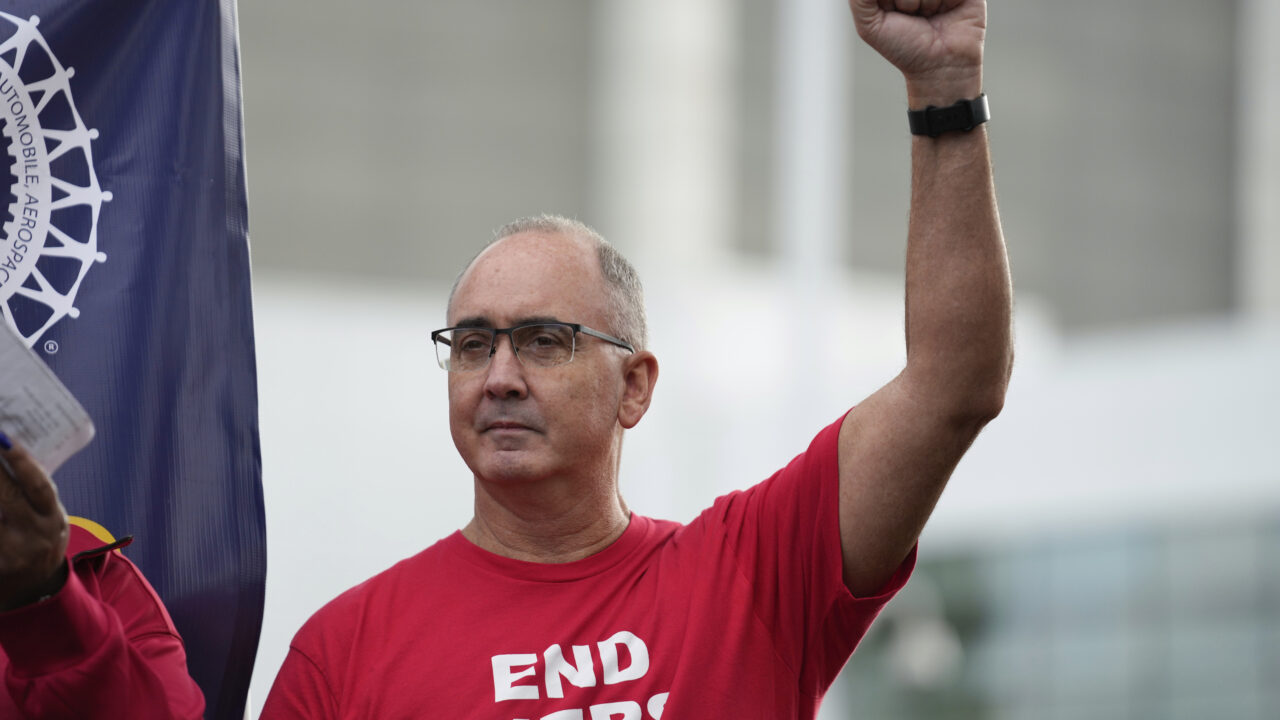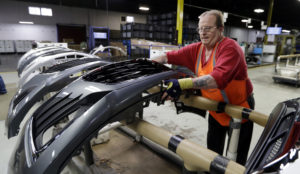The Big Three Back Down
Shawn Fain's "Stand-Up Strike" strategy worked, resulting in massive gains for 146,000 UAW workers who will vote on the new contracts in the coming weeks. United Auto Workers President Shawn Fain raises his fist at a rally in Detroit, on Sept. 15, 2023. (AP Photo/Paul Sancya, File)
United Auto Workers President Shawn Fain raises his fist at a rally in Detroit, on Sept. 15, 2023. (AP Photo/Paul Sancya, File)
All three dominoes fell in a few days.
The Auto Workers (UAW) now have agreements with each of the Big 3 automakers. The new contracts are a sharp about-face from decades of concessions.
The tentative agreements go further than many thought possible on issues that the companies insisted were off the table. Stellantis agreed to reopen its idled Belvidere assembly plant. GM and Stellantis will include new battery plant workers in their master agreements.
While the contracts don’t abolish benefit tiers, they get rid of the many wage tiers the Big 3 had created to drive down pay. Some workers will see their pay more than double as a result.
The gains are a testament to the UAW’s bold, aggressive strategy under its new leadership, which ramped up the strikes, at first slowly and then faster until the companies caved one by one. It was a master class in worker power.
On Monday, the UAW announced it had reached a tentative agreement with General Motors, the last holdout. Workers at GM’s Spring Hill, Tennessee, Cadillac factory had joined the strike Saturday night.
The union announced tentative agreements with Ford and Stellantis last week. The agreements came after UAW members struck at each company’s most profitable truck plant, the latest escalation in the union’s six-week Stand-Up Strike.
The 146,000 UAW members at all three automakers will vote on the contracts in the coming weeks. In the meantime, 50,000 strikers are headed back to work.
FORD DETAILS
On Sunday night, UAW President Shawn Fain and Vice President Chuck Browning laid out the details of the Ford agreement for members in a Facebook Live appearance. (Full details, including the highlights document and the “white book” with all changes, are available at uaw.org/ford2023.)
Fain said each year of the deal is worth more to members than the entire 2019 contract.
The agreement includes 25 percent wage increases over four-and-a-half years, including 11 percent immediately. It reinstates cost-of-living adjustments, a major goal. Combined, that will bring top pay for production workers to $42.60 by the end of the agreement in 2028, up from the current $32.05, while skilled trades will earn more than $50 an hour. Starting pay will increase from $18.05 to $28.
Many workers will see much bigger increases, though. It will now take three years to get to top pay, rather than eight. Members now on the progression will receive immediate 20 to 46 percent bumps.
Workers at two Detroit-area plants, Sterling Axle and Rawsonville Components, will now be on the same wage scale as the rest of the UAW’s members at Ford, meaning that wage tiers at Ford are eliminated. Workers at these two plants had been on a lower tier since 2007, with wages ranging from $16.25 to $22.50. They’ll see immediate raises of 53 to 88 percent.
Fain said each year of the deal is worth more to members than the entire 2019 contract.
Temporary workers with more than 90 days’ service will be converted to permanent status immediately. Future temps will become permanent employees after nine months, and those nine months will count toward their progression to top rate. Over the past two decades the Big 3 have kept temps on for years at low wages; if they were finally “rolled over” to regular status, they would then have to wait another eight years to get to top pay.
To completely end tiers would require that second-tier workers, those hired since 2007, get pensions and retiree health care, as first-tier workers do. Ford did not agree to either of these proposals, which would add significant long-term liabilities.
Instead Ford will put 10 percent of each worker’s pay in a 401(k), a big increase from the current 6.4 percent. The union also won the first increase to the pension multiplier (for workers hired before 2007, who do have pensions) since 2003.
Temps at Ford will receive profit-sharing checks starting in 2024, the first time they’ve been included.
Workers will also have greater ability to choose when to take vacations. Ford will only be able to force workers to use one week of their vacation while laid off for the annual model changeover shutdown.
“While we may not have won everything we wanted, we won more than most people thought was possible,” Fain and Browning wrote in their introduction to the Ford highlights document.
STELLANTIS AND GM CAVE, TOO
The UAW and Stellantis reached a deal Saturday. Full details will be announced on November 2, though the agreement appears to mirror the deal with Ford.
One big issue was the status of Stellantis’s Belvidere Assembly plant in Illinois, which the company idled earlier this year, forcing 1,200 workers to disperse to other plants.
According to the union, the new agreement will bring jobs back to Belvidere, with the company committing to employ two shifts to produce a midsize truck. Stellantis will also add 1,000 jobs at a new battery plant there. “Under our contract, members from Belvidere who have been scattered across this country will have the right to return back home,” said UAW Vice President Rich Boyer.
According to the union, the new agreement will bring jobs back to Belvidere, with the company committing to employ two shifts to produce a midsize truck.
Fain and Boyer said Stellantis will add an additional 5,000 jobs by the end of the agreement, an about-face from the company’s threats to cut thousands of jobs heading into negotiations. The union won the right to strike over product decisions and investment, as well as over plant closures. “That means if the company goes back on their word on any of these plans, we can strike the hell out of them,” said Fain.
The new contract eliminates the lower wage for Stellantis’s Mopar parts division, putting those workers on the same wage scale as other Stellantis workers.
At GM, the last of the Big 3 to cave, the UAW won another big victory against tiers. GM agreed to bring workers at its aftermarket parts depots (CCA), its components plants (GMCH), and its Brownstown, Michigan, battery plant, all up to the rate of production workers.
Workers at GM Subsystems, who currently work under a separate, inferior contract, will now be under the GM master agreement. The company has shifted warehouse and material-handling jobs in several GM plants to the lower-wage Subsystems in recent years, and the union was concerned that it would use the transition to electric vehicles to shift even more types of jobs to the subsidiary. The agreement would end this race to the bottom.
Full details of the GM agreement will be shared by the UAW on November 3.
MAY DAY 2028
The proposed new contracts will all expire on April 30, 2028. At four-and-a-half years, they’re longer than the four-year agreements that have been typical in recent Big 3 contracts.
Fain said the UAW wants to give time for other unions to align their contract expirations with the UAW and strike together on May 1, 2028—International Workers’ Day. “If we’re going to truly take on the billionaire class and rebuild the economy so that it starts to work for the benefit of the many and not the few,” Fain said, “then it’s important that we not only strike, but that we strike together.”
Fain said the UAW wants to give time for other unions to align their contract expirations with the UAW and strike together on May 1, 2028—International Workers’ Day.
Fain hinted that the fight for a shorter workday or workweek could be a part of the UAW’s contract campaign in four-and-a-half years. One of the union’s public demands in this round of bargaining was for a 32-hour week at 40 hours’ pay. Auto workers frequently complain of being forced to work mandatory overtime, including 60-hour weeks (six 10-hour days).
“May Day was born out of an intense struggle by workers in the United States to win an eight-hour day,” said Fain. “That’s a struggle that is just as relevant today as it was in 1889.”
Fain said the other reason for the longer contract was that the UAW is planning a push to organize the many nonunion automakers: Tesla, Toyota, Volkswagen, Mercedes, BMW, Honda, Nissan, and others. “When we return to the bargaining table in 2028, it won’t just be with the Big 3, but with the Big 5 or Big 6,” he said.
Labor Notes received a message from a Toyota worker in Alabama the next day, saying management had called an emergency meeting. Toyota—clearly running scared—was raising top pay to $32, he said, and shortening the time to get there from eight years to four. Another worker at a Toyota plant in Kentucky said the company was boosting wages and slashing the progression to top rate in half there, too. The new top rate will increase to $2.94 to $34.80 for production workers and $3.70 to $43.20 for skilled trades.
EV ORGANIZING
At Ford, the union had wanted a pledge that all electric vehicle plants, including joint ventures, would be brought under the master agreement. It extracted from Ford a pledge to recognize the union at two plants now under construction, the Tennessee Electric Vehicle Center and the Marshall Battery Plant in Michigan, if a majority of workers sign union cards (what union organizers call “card check”). This should be easy for the UAW.
Ford is planning three other battery plants in Tennessee and Kentucky, jointly owned with South Korea’s SK On and scheduled to start production in 2025. There, it appears the union will have to organize the old-fashioned way.
At GM and Stellantis, the gains on electrical vehicles were greater. Each agreed to put workers at their joint venture battery plants under their master agreements. “They told us for years that the electrical vehicle transition was a death sentence for good auto jobs in this country,” Fain said. “With this agreement, we’re proving them all wrong.”
BROKE WITH TRADITION
Fain was elected this year in the UAW’s first-ever one-member, one-vote election, after a corruption scandal landed two of the union’s most recent presidents in jail. His victory ended eight decades of one-party rule in the union.
Fain ran as part of the Members United slate on a platform of “No Corruption, No Concessions, No Tiers.” He beat incumbent Ray Curry by just 500 votes, and took office less than six months before contracts expired at the Big 3.
As president, Fain finally took the union back on the offensive. “For decades, we’ve been fighting with one hand tied behind our back,” he said in announcing the Stellantis agreement. “And to tell you the truth, sometimes it felt like both hands.” Fain is a Stellantis veteran, having cut his teeth as an electrician in Kokomo, Indiana.
“When we return to the bargaining table in 2028, it won’t just be with the Big 3, but with the Big 5 or Big 6.”
Symbolizing the union’s new direction, Fain refused to kick off bargaining with the traditional handshake with company executives. Instead, he and other new UAW leaders inaugurated what they hope will become a new tradition, the Members’ Handshake—greeting members at plant gates to launch a very public contract campaign.
Fain also abandoned the UAW’s long-term strategy of picking a single lead company among the Big 3 to negotiate with first and win an agreement to set the pattern. Instead, the union negotiated with, and struck, all three companies simultaneously.
Fain broadcast bargaining updates publicly via Facebook Live, breaking with the union’s precedent of sharing no information before a tentative agreement was reached. The transparency and boldness won members over—Fain’s videos regularly have 40,000 to 50,000 live viewers on Facebook, and more on other platforms.
And he never hesitated to raise members’ expectations, laying out demands for a 40 percent wage increase, a 32-hour week, and the restoration of pensions and retiree health care to all UAW members at the Big 3.
Members will decide whether the gains are enough to match their heightened expectations. But the UAW is in a much different place than it was six months ago: on the offensive, framing its battles as fights for the entire working class, and showcasing power like it hasn’t done in many years.
Your support matters…Independent journalism is under threat and overshadowed by heavily funded mainstream media.
You can help level the playing field. Become a member.
Your tax-deductible contribution keeps us digging beneath the headlines to give you thought-provoking, investigative reporting and analysis that unearths what's really happening- without compromise.
Give today to support our courageous, independent journalists.






You need to be a supporter to comment.
There are currently no responses to this article.
Be the first to respond.